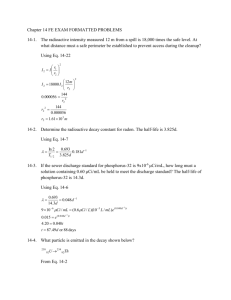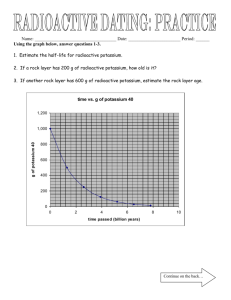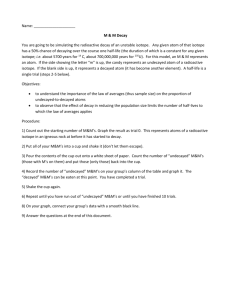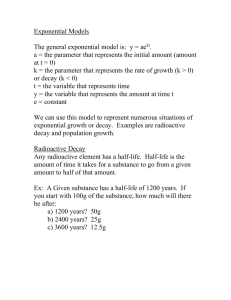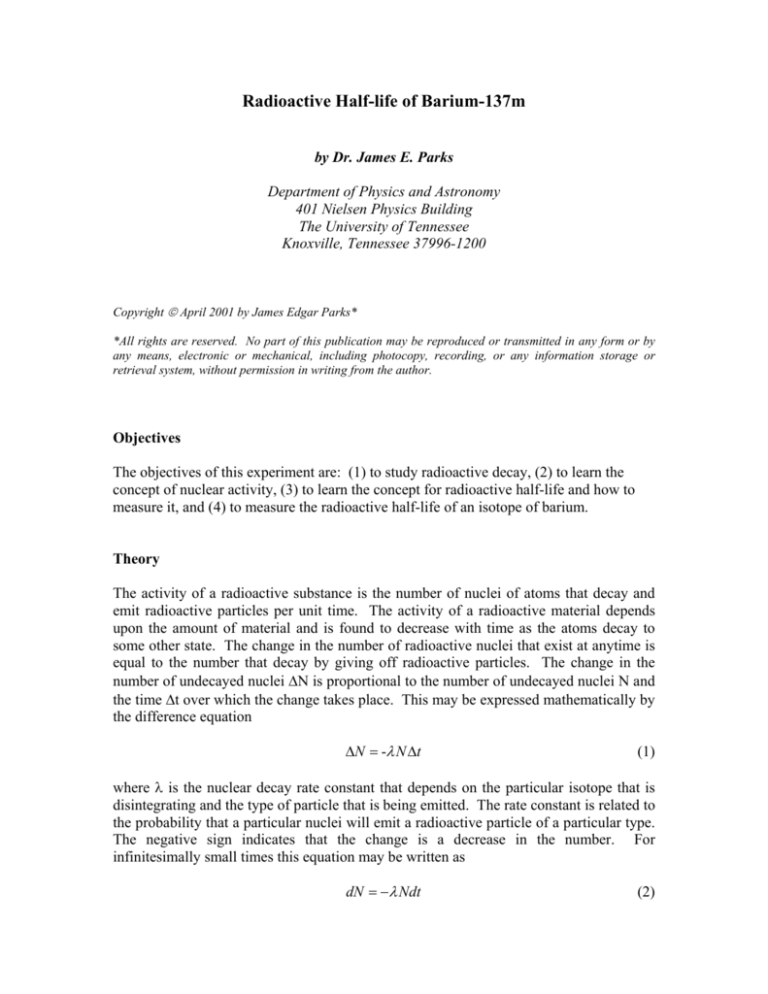
Radioactive Half-life of Barium-137m
by Dr. James E. Parks
Department of Physics and Astronomy
401 Nielsen Physics Building
The University of Tennessee
Knoxville, Tennessee 37996-1200
Copyright © April 2001 by James Edgar Parks*
*All rights are reserved. No part of this publication may be reproduced or transmitted in any form or by
any means, electronic or mechanical, including photocopy, recording, or any information storage or
retrieval system, without permission in writing from the author.
Objectives
The objectives of this experiment are: (1) to study radioactive decay, (2) to learn the
concept of nuclear activity, (3) to learn the concept for radioactive half-life and how to
measure it, and (4) to measure the radioactive half-life of an isotope of barium.
Theory
The activity of a radioactive substance is the number of nuclei of atoms that decay and
emit radioactive particles per unit time. The activity of a radioactive material depends
upon the amount of material and is found to decrease with time as the atoms decay to
some other state. The change in the number of radioactive nuclei that exist at anytime is
equal to the number that decay by giving off radioactive particles. The change in the
number of undecayed nuclei ΔN is proportional to the number of undecayed nuclei N and
the time Δt over which the change takes place. This may be expressed mathematically by
the difference equation
ΔN = -λ N Δt
(1)
where λ is the nuclear decay rate constant that depends on the particular isotope that is
disintegrating and the type of particle that is being emitted. The rate constant is related to
the probability that a particular nuclei will emit a radioactive particle of a particular type.
The negative sign indicates that the change is a decrease in the number. For
infinitesimally small times this equation may be written as
dN = −λ Ndt
(2)
Radioactive Half-life of Barium-137m
and solved by the methods of calculus to yield
N = N o e − λt
(3)
which is the number N of undecayed nuclei at any time t when the initial number at t = 0
is No. The symbol “e” is the natural exponential number 2.7138.
Since the activity of a sample is the time rate of change of N, the activity A of a sample is
defined by
A=
ΔN
dN
=
= -λ N = λ N
Δt
dt
(4)
and is proportional to the number of radioactive nuclei. Since the activity is proportional
to the number of radioactive nuclei, the activity will have the same time behavior and will
change at same rate as the number of nuclei. Therefore, the activity is given by
A = λ N o e − λt
(5)
A = Ao e − λt
(6)
and
where Ao is the initial activity of the sample at time t = 0, and is equal to λNo. The
activity of a sample can be measured as a function of time and the rate constant can be
determined experimentally.
The SI unit of activity is the becquerel and is defined as the activity of a radionuclide that
has a decay rate of one spontaneous nuclear transition per second. Historically, the
standard unit of activity is the Curie (Ci) and is still the most often used unit for
expressing activity. One Curie is equal to 3.7 x 1010 becquerels. (1 Ci = 3.7 x 1010 Bq.)
Typical exempt sources that can be purchased without a license have activities of a few
microcuries, i.e. 10-6 Ci.
A useful concept in nuclear methods is the time that it takes the activity of a given
radioactive sample to decrease by half of its original activity. This time is known as the
nuclear half-life and can be used to help identify an unknown radioisotope. The nuclear
half-life τ depends on the decay rate constant λ so that the larger the decay rate, the
smaller the half-life. The nuclear half-life τ is defined such that if the initial activity is Ao
at time t = 0, then the activity at time t = τ will be A = ½Ao and
1
Ao = Ao e− λτ .
2
2
(7)
Radioactive Half-life of Barium-137m
This equation may be solved for the half-life by simplifying and taking the natural
logarithm of both sides of the equation. By dividing both sides of Equation (7) by Ao and
by taking the inverse of each side, Equation (7) becomes
1
= e − λτ
2
(8)
2−1 = e− λτ
(9)
2 = eλτ .
(10)
and
and
Taking the natural logarithm of each side of this equation yields
ln 2 = ln eλτ ,
(11)
ln 2 = λτ ,
(12)
and
τ=
ln 2
λ
.
(13)
Since ln 2 = 0.693, the nuclear half-life τ can be computed from a measurement of the
decay rate constant λ and the simple relationship
τ=
0.693
λ
.
(14)
The decay rate constant for a particular isotope may be found by measuring the activity
of a sample as a function of time and analyzing the results.
When a quantity N decreases exponentially with time t as the activity A of a radioactive
sample does, a plot of Ln(N) versus t will result in points that lie along a straight line.
The equation for this straight line will be of the form, N = N o e − λt , and the decay rate
constant λ characterizes how fast the quantity N or A changes with time and is different
for different radioactive isotopes.
If the natural logarithm of N is taken, then
and
ln N = ln N o e− λt ,
(15)
ln N = ln N o + ln e− λt ,
(16)
ln N = ln N o − λ t .
(17)
3
Radioactive Half-life of Barium-137m
This equation is in the form of an equation for a straight line, y = a + bx, where y = ln N,
a = ln N0, x = t, and b = -λ. If ln N is plotted as a function of t, then the results should be
a straight line whose slope is negative and has the value λ. Therefore, the rate constant λ
may be found from a plot of ln N versus t and linear regression.
Apparatus
The apparatus is shown in Figure 1 and consists of (1) a Nucleus scaler/timer, (2) GeigerMueller tube with stand and source holder, (3) a cesium/barium-137m isogenerator, (4)
planchet, (5) a source holder tray, (6) Pasco Science Workshop 750 data interface, (7)
Pasco Science Workshop software, (8) Excel software, and (9) computer system.
Figure 1. Apparatus for measuring the half-life of Ba-137m.
The performance of the Geiger counter depends on the high voltage supply and that has
been pre-set for this experiment. Normally, an experiment would be run to determine the
operating voltage, but that process has been eliminated for this experiment to concentrate
on the study of the measurement of the half-life. Unless instructed otherwise, the high
voltage for the counter should be set at 900 volts.
The instructor will make the Ba-137m source for each experimenter when ready.
Counting should start as soon as possible after the sample is made. After the run, the
planchet with the used Ba-137m source material should be placed in a baking dish in the
sink to be washed. After each Ba-137m source, it takes about 5.0 minutes for the Ba137m to build back to 3/4 strength. Thus the instructor should rotate through several
isogenerators for each class. Remember to wipe up any spills and to wash yourself
thoroughly if any of the source material should come in contact with your skin.
4
Radioactive Half-life of Barium-137m
Method
In this experiment a G-M tube with a scaler/timer will be used to measure the radioactive
half-life of an isotope of barium, Ba-137m, a metastable state of barium before it decays
to its ground state. The activity of the Ba-137m is measured as a function of time by
detecting the gamma rays that are emitted and the half-life is computed from the decay
rate constant.
The activity of the sample cannot be measured instantaneously, but instead a number of
radioactive decays are detected and counted over a series of short time intervals. It can
be shown that this number changes exponentially with the same decay constant as the
activity, and therefore, is equivalent to measuring the instantaneous activity. Also, the
number of detected particles is a fraction of the total number of decays since the radiation
is emitted from the source in all directions and the detector only intercepts a small portion
of these directions. In other words, the detector only sees a small fraction of the total
solid angle. The detector also has an efficiency for counting particles that enter it that is
less than 100%. The efficiency is usually a constant for a given setup and a set of
measurements, but the measurements still have the characteristic exponential relationship
with the same decay constant. For high count rates, detectors in general but especially
GM tubes, have difficulty counting particles that occur nearly simultaneously. This
problem, referred to as the dead time, can be avoided by keeping the counting rates small
enough that the time between counts is much larger than the time resolution of the
detector and counter. With these additional factors taken into consideration, the detected
number of particles is still proportional to the activity of the sample and has the same
decay constant.
Background radiation is a common source of error in radioactive decay counting, and
although small, this error can lead to a small inaccuracy in the measurement of the halflife. The background radiation comes from a lot of naturally occurring materials that
emit radiation, and also, from cosmic rays entering our upper atmosphere from space.
Background radiation is a constant addition to the detected activity and produces an
offset count that doesn’t fit the exponential decay of the source material. Fortunately, the
measurements can be easily corrected to compensate for this offset. A background
measurement is made by removing all other sources to be measured from the vicinity of
the detector and then counting for a long time to establish an accurate measurement of the
background. Then the background is simply subtracted from each of the measurements
made with the sources present.
The source material for Ba-137m is an isotope generator consisting of an exempt quantity
of Cs-137. An exempt quantity is a quantity small enough that no license is required to
purchase the material and therefore is deemed to be a minimal health hazard. The cesium
atoms are in molecules of a cesium salt, CsCl that have been adsorbed by small beads of
a resin material. The Ba-137m atoms are a daughter product that results from the decay
of Cs-137 according to the scheme shown in Figure 2. As the Cs-137 atoms decay to the
Ba-137m atoms, the Ba-137m atoms remain adsorbed on the surface of the resin, but
because barium is in a different chemical form than the cesium was previously, it is more
5
Radioactive Half-life of Barium-137m
loosely bound to the resin and can be de-adsorbed with a weakly acidic salt solution
containing HCl and NaCl. Small aliquots of the short lived Ba-137m isotope can then be
extracted from the resin by this eluting solution. The cesium atoms have a half-life of 30
years and is always decaying and building up an equilibrium amount of Ba-137m.
Ba-137m has a half-life of only 2.55 minutes (153 seconds) and quickly decays down to
its stable ground state by the emission of a 0.662 MeV gamma ray.
30.0 y
137
55
Cs
93.5% β
E max=514 keV
137m
56
Ba
2.55 m
-
6.5% β
E max=1.176 MeV
γ
661.6 keV
137
Ba
Figure 2. Decay scheme for cesium-137.
The Ba-137m is said to be selectively "milked" from the generator that is sometimes
referred to as a “cow.” As the Ba-137m daughter product is washed out of the generator,
the Cs-137 parent product is left behind to regenerate additional Ba-137m atoms.
Regeneration of the Ba-137m occurs as the Cs-137 continues to decay and equilibrium is
re-established in less than an hour. Since Ba-137m has a short half-life, it only takes
approximately 30 minutes after a sample is acquired for the residual activity to have
decayed to less than one thousandth of its initial activity, thus making it safe for disposal.
However, regardless of how safe this isotopic generator system is to work with, care
should be taken to avoid spills and contact with your skin. Should a spill occur or contact
with the skin be made, wipe off the excess liquid and wash thoroughly with soap and
water.
CAUTION: Avoid skin contact with aliquots of the Ba-137m samples. Wipe up any
spills and wash thoroughly with soap and water.
6
Radioactive Half-life of Barium-137m
Procedure
Preliminary Preparation
1. The LND, Inc. Model 723 Geiger-Mueller tube used in this experiment has an
operating voltage of 900 volts. Make sure the high voltage on the scaler/timer unit is
set to 900 volts (the two knobs set to 800 volts and 100 volts respectively). The end
window of the tube is made of mica and has a thickness of 7 x 10-4 cm (7 microns).
CAUTION: The window is extremely thin, and can be easily punctured so that the
900 volts on the center wire is exposed, thus posing an electrical health hazard.
Avoid contact with the window to avoid the possibility of a serious electrical shock.
2. Turn on the power to the scaler/timer unit with the power rocker switch. Push the
stop and reset rocker switches to initialize the unit.
3. Open up an Excel Spreadsheet by clicking on the Excel icon on the desktop of the
computer. In Sheet 1, label the columns as illustrated in Figure 3.
4. With all sources removed from proximity of the detector, make a background
measurement. On the scaler/timer unit set the mode switch to preset time by
switching the toggle switch to the left. Set the preset time knob to 10 minutes and
start the scaler by pushing start rocker switch to on.
5. Record the number of background counts NT in Cell C1 of your spreadsheet and
compute the number of counts per 30 second period NB in Cell C2. (NB=NT/20).
Figure 3. Example of Excel spreadsheet for recording and analyzing data for the half-life
of the beta decay of Ba-137m.
Data Acquisition Setup
1. From the desktop open the DataStudio program by clicking on the DataStudio icon.
2. Select Create an Experiment from the choices in the Welcome to DataStudio pop-up
window.
7
Radioactive Half-life of Barium-137m
3. In the Experiment Setup window scroll through the list of Sensors in the pull-down
. Double click on the Geiger
menu to the Geiger Counter sensor icon,
Counter sensor icon to add it to Digital Channel 1. Check and make sure that the
cable connected to the Nucleus scaler is plugged into Digital Channel 1 on you 750
interface.
4. Double click on the Geiger Counter sensor icon connected to the 750 interface in the
Experiment Setup window. This brings up the Sensor Properties window. Under
the general tab, click on the Slow [<1 Hz] button to select it (if it isn’t already
selected), and change the Seconds Between Samples input box to 30 sec using the +/buttons,
. This setting will set the data acquisition system to count for 30 second
periods. Click on the Measurement tab in this window. Make sure that the Geiger
Couuts, Ch1 (counts/sample) check box is checked, and then click OK.
5. Click on the Options button on the Setup Toolbar and this will bring up the Sampling
Options window. This window can be used to control the starting and stopping of
data collection. In the Delay Start section, click the radio button to select None.
6. In the automatic stop section, select the radio button Time and set the time to 901
seconds. This will allow 30 measurements of the number of counts that occur in 30
second increments.
7. Under the Displays window double click both on the graph icon and the table icon.
This will display the data collected from the Geiger counter in a table and graph.
8. Arrange the graph and table windows to best display your results. You can hide the
Displays and Data windows by clicking on the small up and down arrow beside the
Summary button on the DataStudio toolbar.
9. When ready to start collecting the data, click the Start button. The data will be
recorded in the table and graphed on the graph. If for some reason data collection
doesn’t stop, you can stop data collection by clicking on the Stop button.
10. On each of the window’s Graph and Table there is a drop down menu beside the
toolbar button labeled Data. Select Clear Data from the drop down menu. This will
allow you to run the experiment again. Each data set is saved separately, so you can
run as many trials as you want to run so that you can then go back and compare your
results.
8
Radioactive Half-life of Barium-137m
Acquisition of Ba-137m Half-life Data
Note: Sample preparation should be done only after the apparatus is setup, a background
measurement has been made, the scaler and software are initialized, and you are ready to
begin counting. The sample will lose half of its activity in 153 seconds, the half-life of
Ba-137m, and the best data occurs during the first few measurements. Make sure you are
set to operate the experiment correctly and can start data acquisition as soon as possible
after the sample is prepared. Read through the following steps before beginning.
1. Prepare to measure the activity of a sample of Ba-137m as a function of time by
counting detected beta particles for 30-second time intervals and repeating the
measurement for 15 minutes (900 seconds). As was outlined above, the Pasco
Science Workshop data acquisition should be set to count for 30 second time intervals
and to stop when the time is greater than 900 seconds.
2. To initialize the scaler, turn it on with the Power rocker switch, and then place the
scaler in the stopped mode by depressing the Stop rocker switch followed by
depressing the Reset and Count rocker switches in sequence.
3. To initialize the software if any previous data has been collected, select Experiment
from the DataStudio main menu bar and then Delete All Data Runs from the pull
down menu. Click on OK and the experiment is set to take data. When the sample is
ready, data acquisition will be initiated by clicking on the Start button of the Pasco
DataStudio software.
4. Ask your lab instructor to prepare your sample of Ba-137m using one of the isotope
minigenerators. Two or three drops should be placed in the center of a planchet that
has already been placed in a source tray holder.
5. Quickly place the source tray in the second slot from the top slot of the holder stand,
and then click on the Start button of DataStudio to start collecting data. Make sure
the scaler is showing that it is registering counts. After the first 30 seconds has
elapsed, observe the data as it is being accumulated in the table. If you should need
to stop data acquisition , click on the Stop button.
6. Collect data for the next 15 minutes and observe the accumulated data as it is plotted
in the graph. Observe the exponential decrease of the number of counts recorded in
each time period.
Analysis of Results
1. Prepare to transfer the data from DataStudio to your Excel spreadsheet for analysis.
Using the left mouse button, click on the area of Table 1 that has the title Geiger
Counts, Ch1 and Run #x. This will highlight in yellow all the numbers in the table.
(As an alternative, click on the uppermost of the cells in the left column of time data
9
Radioactive Half-life of Barium-137m
and while holding the left mouse button down, drag the cursor to the lowermost cell
containing data in the right, counts, column to select the entire data set of Geiger
counts versus time. Then select the Edit menu option from the top menu bar of the
DataStudio program and then select Copy.
2. Return to Sheet 1 of the Excel program and locate your cursor in cell A4 and click on
this cell with the left button of your mouse. Choose the Edit option from the top
menu bar and then select Paste. These operations should place your data from your
run into the spreadsheet. Examine the copied data to make sure that this has been
done. Your spreadsheet should look something like the one in Figure 3.
3. In column C, compute the number of Geiger counts corrected for the background,
NG-NB. This can be done by copying the formula =B6-$C$2 in cell C6 and copying it
to the other cells in column C.
4. In the following steps, NG-NB will be graphed as a function of time, t. To make the
graph, begin by choosing Insert from the Excel main menu bar and then Chart . . .
from the pull down menu. Choose XY (Scatter) for the Chart type and the points only
, from Chart sub-type selections. Click on Next and then click on the
option,
Series tab of the Chart Source Data window. Click the Add series button and type
Ba-137m Half-life in the Name text input box. Type =Sheet1!$A$6:$A$35 in the X
Values text input box and =Sheet1!$C$6:$C$35 in the Y Values text input box and
then click on Next.
5. In the Chart Options window click on the Titles tab and type in Time (seconds) and
NG-NB in the Value X axis and Value Y axis text boxes. Under the Gridlines tab
check both the x and y Major gridlines options and then click on Next.
6. In the Chart Location window, choose the As new sheet option and then click on
Finish. Note the exponential decay of the data as it appears in your graph.
7. Since Equation (17) is the form of a linear equation, graphical analysis using linear
regression can be used to find the coefficients and decay constants. Use column D to
compute the natural logarithm of the corrected number of counts found in column C.
A formula, =LN(C6), can be entered in cell D6 and then copied down to D35.
8. In the next steps, ln(NG-NB) will be graphed and analyzed as a function of time, t.
According to the theory, the graph should result in a straight line whose slope is -λ.
All the points on the graph should appear to lie along a straight line, and the slope of
the line that fits these points will be found by linear regression using the trendline
feature of Excel.
9. To graph the data, choose Insert from the Excel main menu bar and then Chart . . .
from the pull down menu. Choose XY (Scatter) for the Chart type and the points only
option,
, from Chart sub-type selections. Click on Next and then click on the
10
Radioactive Half-life of Barium-137m
Series tab of the Chart Source Data window. Click the Add series button and type
Ba-137m Half-life in the Name text input box. Type =Sheet1!$A$6:$A$35 in the X
Values text input box and =Sheet1!$D$6:$D$35 in the Y Values text input box and
then click on Next.
10. In the Chart Options window click on the Titles tab and type in Time (seconds) and
Ln(NG-NB) in the Value X axis and Value Y axis text boxes. Under the Gridlines tab
check both the x and y Major gridlines options and then click on Next.
11. In the Chart Location window, choose the As new sheet option and then click on
Finish.
12. Examine the points on the graph to see if they lie along a straight line. Choose Chart
from the Excel main menu bar and Add Trendline . . . from the pull down menu.
Choose Linear from the Trend/Regression type selections under the Type tab. Under
the Options tab, click on the Display equation on chart option and then OK. Reexamine the data points with regard for how well they fit the trendline.
13. This graph should look something the one in Figure 4. The slope of the trendline for
the second portion of the graph is negative and is equal to -λ, the decay constant.
Record the value of the slope taken from the equation of the trendline in a convenient
cell in sheet 1. Use another adjacent cell in the same row or column to label this
value.
14. Using Equation (14), calculate the half-life for Ba-137m and record this value in your
spreadsheet. Calculate the percent difference between your value for the half-life of
Ba-137m and the accepted value of 153 seconds. Record this difference in your
spreadsheet with it labeled.
Figure 4. Example graph of Ba-137m decay versus time.
11
Radioactive Half-life of Barium-137m
15. Examine the data in columns A and C and determine the time that the number of
detected counts is reduced by a factor of 2. Refer to your first graph to refine this
estimate. Compare this value to the value you determined from your analysis and the
accepted value for the half-life
16. Print copies of your spreadsheet and graphs.
Questions
1. What was the number of Geiger counts corrected for background that would have
been measured at time t=0? Hint: Use the equation for your trendline to compute the
natural log of this value and then convert it to a linear value.
2. If two different radioisotopes A and B have the same activity but the half-life of
isotope A is larger than the half-life of isotope B, what is the relative magnitude of
the numbers of radioactive nuclei of isotope, A to isotope B?
3. A unit of activity called the curie is defined as 3.7 x 1010 disintegrations/second.
What is the activity in microcuries of an strontium source that emits 2250 beta
particles per minute? (1 microcurie = 10-6 curies).
4. In this experiment are the detected activity and actual activity of the source identical?
What difference would this make in the analysis of the data?
5. The half-life of radioactive phosphorus (P-32) is 14.3 days. If a solution containing
10 microcuries is purchased for an experiment on the absorption of phosphates by
plants, what would the activity be after 21 days?
12



